完整版初中介词和介词短语专题讲解含练习
初中英语介词专项讲解及练习(包含答案)
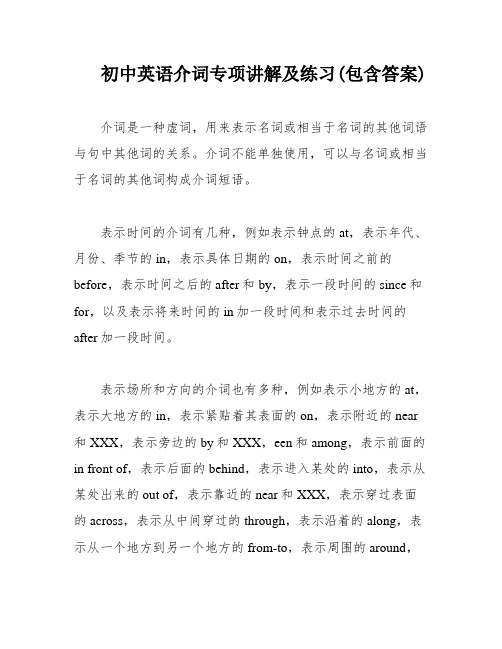
初中英语介词专项讲解及练习(包含答案)介词是一种虚词,用来表示名词或相当于名词的其他词语与句中其他词的关系。
介词不能单独使用,可以与名词或相当于名词的其他词构成介词短语。
表示时间的介词有几种,例如表示钟点的at,表示年代、月份、季节的in,表示具体日期的on,表示时间之前的before,表示时间之后的after和by,表示一段时间的since和for,以及表示将来时间的in加一段时间和表示过去时间的after加一段时间。
表示场所和方向的介词也有多种,例如表示小地方的at,表示大地方的in,表示紧贴着其表面的on,表示附近的near和XXX,表示旁边的by和XXX,een和among,表示前面的in front of,表示后面的behind,表示进入某处的into,表示从某处出来的out of,表示靠近的near和XXX,表示穿过表面的across,表示从中间穿过的through,表示沿着的along,表示从一个地方到另一个地方的from-to,表示周围的around,表示正上方的over,表示正下方的under,表示斜上方的above,表示斜下方的below。
介词的使用需要根据具体情况来判断,掌握介词的用法可以帮助我们更准确地表达自己的意思。
In using a language。
it'XXX to know about the culture and customs of the people you are XXX my experience。
as someone who has lived in different countries。
it's important to adapt and be respectful。
just like you would in your own country.With the right clothing and knowledge。
you can XXX。
完整版)初中介词讲解及练习题
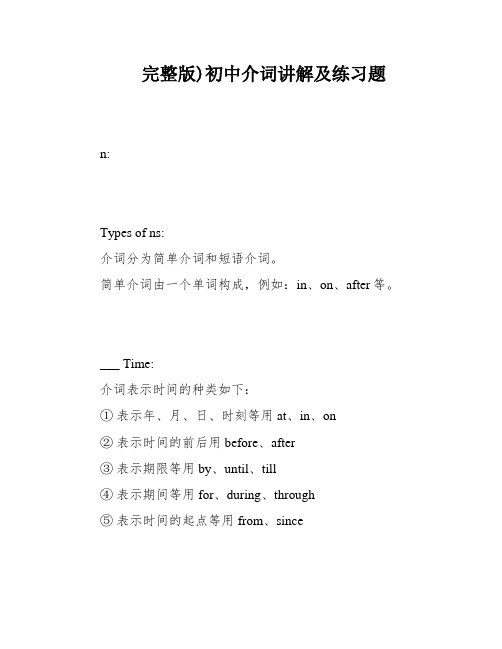
完整版)初中介词讲解及练习题n:Types of ns:介词分为简单介词和短语介词。
简单介词由一个单词构成,例如:in、on、after等。
___ Time:介词表示时间的种类如下:①表示年、月、日、时刻等用at、in、on②表示时间的前后用before、after③表示期限等用by、until、till④表示期间等用for、during、through⑤表示时间的起点等用from、sinceExamples:1) at、on、inA。
at:用于表示时间的某一点例如:at ___在午饭时、___早餐时、___正午时、___那时、___在夜间、___此刻、目前、___目前、___(o’clock)在九点钟、at first开始的时候、起初、at/on the weekend在周末、at last最后、at the same time同时、at times偶尔、有时、at the end of 1999在1999年末、at this time of(the)year在一年中的这个时候。
例如:We usually have ___ ___.我们通常中午吃午饭(十二点吃午饭)。
B。
on:用于表示某天、某一天的上、下午(指具体的某一时,一律用on)例如:on ___在周一、on ___在周二早上、on June 6在6月6日、on May 4,1996在1996年5月4日、on a cold night在一个寒冷的夜晚、on that day在那天、on Christmas Day在圣诞节那天、on time准时、___在周一晚上。
___表示“到……为止”,常用于表示时间或完成某个动作的期限___。
我需要在明天之前完成这份报告。
___ to come by 5 o'clock。
他承诺在5点之前到达。
___表示“直到……为止”,常用于表示时间或某个动作的持续时间___ ___。
她等到午夜才等到她的朋友到来。
(完整word版)初中介词(表时间地点介词)讲解练习及答案.doc
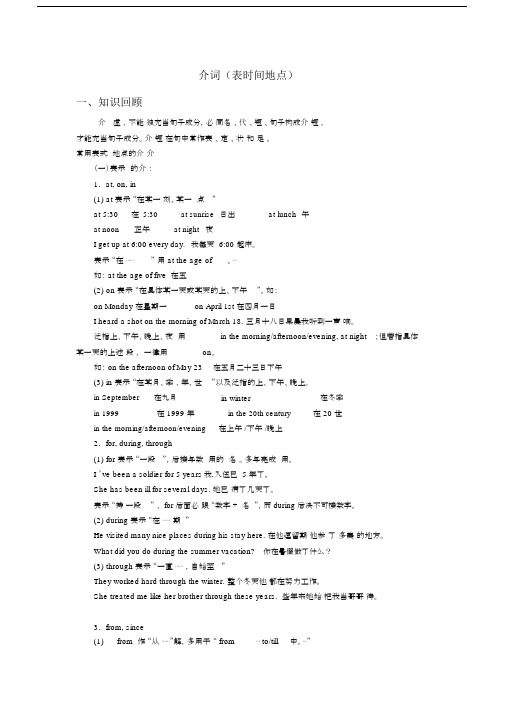
介词(表时间地点)一、知识回顾介虚,不能独充当句子成分,必同名、代、短、句子构成介短,才能充当句子成分。
介短在句中常作表、定、状和足。
常用表式地点的介介(一)表示的介:1. at, on, in(1)at 表示“在某一刻、某一点”at 5:30 在5:30 at sunrise 日出at lunch 午at noon 正午at night 夜I get up at 6:00 every day.我每天6:00起床。
表示“在⋯⋯” 用at the age of。
⋯如: at the age of five 在五(2)on 表示“在具体某一天或某天的上、下午”。
如:on Monday 在星期一on April 1st 在四月一日I heard a shot on the morning of March 18. 三月十八日早晨我听到一声响。
泛指上、下午、晚上、夜用in the morning/afternoon/evening, at night;但若指具体某一天的上述段,一律用on。
如: on the afternoon of May 23在五月二十三日下午(3)in 表示“在某月、季、年、世”以及泛指的上、下午、晚上。
in September 在九月in winter 在冬季in 1999 在 1999 年in the 20th century 在 20 世in the morning/afternoon/evening 在上午 /下午 /晚上2. for, during, through(1)for 表示“一段”,后接与数用的名。
多与完成用。
I ’ve been a soldier for 5 years我.入伍已 5 年了。
She has been ill for several days. 她已病了几天了。
表示“持一段” , for 后面必跟“数字 +名”,而 during 后决不可接数字。
初中英语介词解题技巧讲解及练习题(含答案)含解析
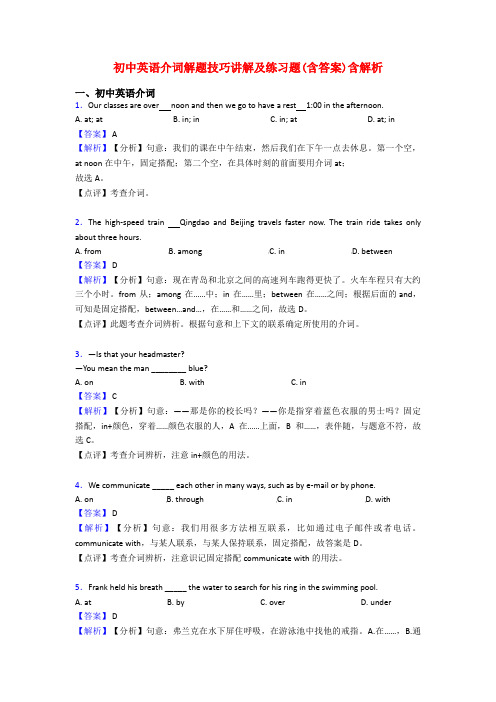
初中英语介词解题技巧讲解及练习题(含答案)含解析一、初中英语介词1.Our classes are over noon and then we go to have a rest 1:00 in the afternoon. A. at; at B. in; in C. in; at D. at; in【答案】 A【解析】【分析】句意:我们的课在中午结束,然后我们在下午一点去休息。
第一个空,at noon在中午,固定搭配;第二个空,在具体时刻的前面要用介词at;故选A。
【点评】考查介词。
2.The high-speed train Qingdao and Beijing travels faster now. The train ride takes only about three hours.A. fromB. amongC. inD. between【答案】 D【解析】【分析】句意:现在青岛和北京之间的高速列车跑得更快了。
火车车程只有大约三个小时。
from 从;among 在……中;in 在……里;between 在……之间;根据后面的and,可知是固定搭配,between…and…,在……和……之间,故选D。
【点评】此题考查介词辨析。
根据句意和上下文的联系确定所使用的介词。
3.—Is that your headmaster?—You mean the man ________ blue?A. onB. withC. in【答案】 C【解析】【分析】句意:——那是你的校长吗?——你是指穿着蓝色衣服的男士吗?固定搭配,in+颜色,穿着……颜色衣服的人,A 在……上面,B 和……,表伴随,与题意不符,故选C。
【点评】考查介词辨析,注意in+颜色的用法。
4.We communicate _____ each other in many ways, such as by e-mail or by phone.A. onB. throughC. inD. with【答案】 D【解析】【分析】句意:我们用很多方法相互联系,比如通过电子邮件或者电话。
(完整版)初中英语语法介词用法讲解与练习
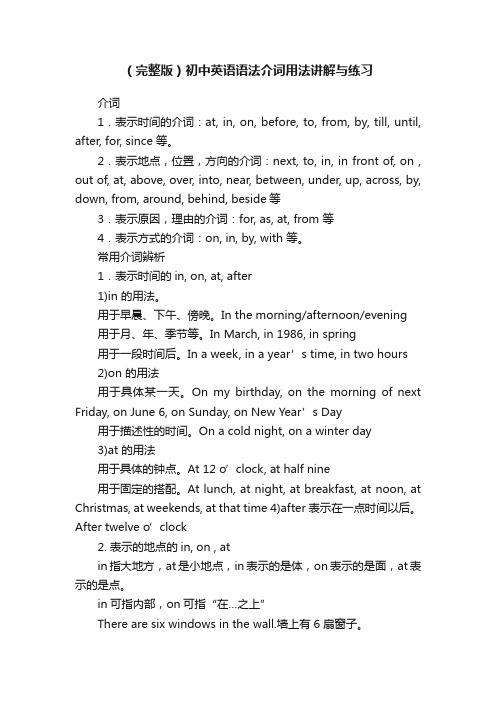
(完整版)初中英语语法介词用法讲解与练习介词1.表示时间的介词:at, in, on, before, to, from, by, till, until, after, for, since 等。
2.表示地点,位置,方向的介词:next, to, in, in front of, on , out of, at, above, over, into, near, between, under, up, across, by, down, from, around, behind, beside等3.表示原因,理由的介词:for, as, at, from 等4.表示方式的介词:on, in, by, with 等。
常用介词辨析1.表示时间的in, on, at, after1)in 的用法。
用于早晨、下午、傍晚。
In the morning/afternoon/evening用于月、年、季节等。
In March, in 1986, in spring用于一段时间后。
In a week, in a year’s time, in two hours2)on 的用法用于具体某一天。
On my birthday, on the morning of next Friday, on June 6, on Sunday, on New Year’s Day用于描述性的时间。
On a cold night, on a winter day3)at 的用法用于具体的钟点。
At 12 o’clock, at half nine用于固定的搭配。
At lunch, at night, at breakfast, at noon, at Christmas, at weekends, at that time 4)after 表示在一点时间以后。
After twelve o’clock2. 表示的地点的in, on , atin指大地方,at是小地点,in表示的是体,on表示的是面,at表示的是点。
(完整word版)中考介词专题讲解及练习
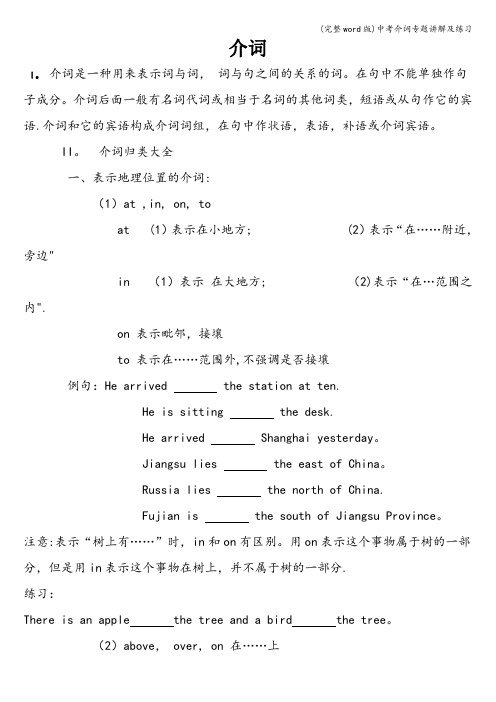
介词I。
介词是一种用来表示词与词,词与句之间的关系的词。
在句中不能单独作句子成分。
介词后面一般有名词代词或相当于名词的其他词类,短语或从句作它的宾语.介词和它的宾语构成介词词组,在句中作状语,表语,补语或介词宾语。
II。
介词归类大全一、表示地理位置的介词:(1)at ,in, on, toat (1)表示在小地方; (2)表示“在……附近,旁边"in (1)表示在大地方; (2)表示“在…范围之内".on 表示毗邻,接壤to 表示在……范围外,不强调是否接壤例句:He arrived the station at ten.He is sitting the desk.He arrived Shanghai yesterday。
Jiangsu lies the east of China。
Russia lies the north of China.Fujian is the south of Jiangsu Province。
注意:表示“树上有……”时,in和on有区别。
用on表示这个事物属于树的一部分,但是用in表示这个事物在树上,并不属于树的一部分.练习:There is an apple the tree and a bird the tree。
(2)above, over, on 在……上above 指在……上方,不强调是否垂直,与 below相对;over指垂直的上方,与under相对,但over与物体有一定的空间,不直接接触。
on表示某物体上面并与之接触。
例句:The bird is flying my head。
There is a bridge the river。
He put his watch the desk。
(3)below, under 在……下面under表示在…正下方below表示在……下,不一定在正下方例句 There is a cat the table。
初一介词详解及练习题(专项训练)

5.介词+名词+介词in front of; at the age of; at the end of
6.介词+动名词短语after leaving school; after finishing it
7.介词+代词for her; from each other; after him
8.其他词+介词instead of; because of; according to
We went there in six days. (过去时中in表....时间内)
We went there after six days. (过去时中after表....时间后)
We often do our homework after school. (固定词组, after class; after supper等)
A. above B. against C. for
11. What a nice day! We should go sightseeing _____ watching TV in the hotel.
A. because of B. instead of C. together with
12. Your coat looks very nice. What’s it made ______?
2.There is a white car ______ our school.
3.Many shops are ______ our home.
4._______ our city there is a river.
练习二:
初一英语介词专题讲解及练习
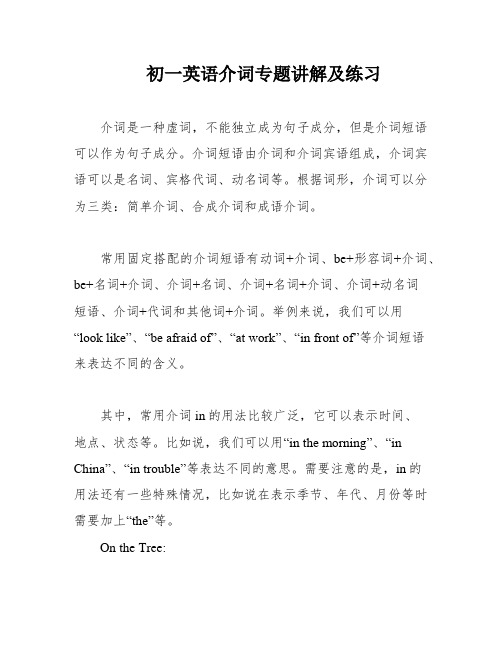
初一英语介词专题讲解及练习介词是一种虚词,不能独立成为句子成分,但是介词短语可以作为句子成分。
介词短语由介词和介词宾语组成,介词宾语可以是名词、宾格代词、动名词等。
根据词形,介词可以分为三类:简单介词、合成介词和成语介词。
常用固定搭配的介词短语有动词+介词、be+形容词+介词、be+名词+介词、介词+名词、介词+名词+介词、介词+动名词短语、介词+代词和其他词+介词。
举例来说,我们可以用“look like”、“be afraid of”、“at work”、“in front of”等介词短语来表达不同的含义。
其中,常用介词in的用法比较广泛,它可以表示时间、地点、状态等。
比如说,我们可以用“in the morning”、“in China”、“in trouble”等表达不同的意思。
需要注意的是,in的用法还有一些特殊情况,比如说在表示季节、年代、月份等时需要加上“the”等。
On the Tree:XXX are called "on the tree"。
This can refer to fruits。
leaves。
branches。
or anything else that is attached to the tree。
In the Tree:When we say "in the tree"。
we are usually XXX or living in the tree。
Using "In" and "With":When we use "in"。
we are talking about the material that something is made of。
For example。
we write in ink or in pencil。
When we use "with"。
- 1、下载文档前请自行甄别文档内容的完整性,平台不提供额外的编辑、内容补充、找答案等附加服务。
- 2、"仅部分预览"的文档,不可在线预览部分如存在完整性等问题,可反馈申请退款(可完整预览的文档不适用该条件!)。
- 3、如文档侵犯您的权益,请联系客服反馈,我们会尽快为您处理(人工客服工作时间:9:00-18:30)。
介词及介词短语【考点直】1.常用介及其的主要用法及意2.介表示、方位、方式的基本用法3.—些易混介的辨析[法解】♦介词的功能介是一种虚,用来表示名或相当于名的其它句中其它的关系,不能独使用。
介可与名或相当于名的其它构成介短。
介短可在句中作定,状,表和足。
例如:The boy over there is John brother・(定 )The girl will be back in two hours.(状)♦介词和种类(1)介,常用的有at, in, on, about, across, before, beside, for , to, without 等。
(2)复合介,女D by means of, along with, because of, in front of, instead of 等。
♦不同介词的用法(1)表的介1)at, in on表示点用atp例女口:at six o' clock, at noon, at midnight o表示在某个世,某年,某月,某个季以及早晨,上午,下午,晚上,用in。
例如:in the nineteenth century, in 2002, in may, in winter, in the morning, in the afternoon 等。
表示具体的某一天和某一天的上午,下午,晚上,用0%例如I: on Monday, on July 1st, on Sunday morning 等。
2)since, after由since和after引的都可表示从去某一点开始的段,但since表示的段一直延到的刻,因而往往要与在完成用。
而alter所表示的段系去,因而要与一般去用。
例如:I haven 9 the a rd from him since last summer ・After five days the boy came back.3)in, afterin与将来用,表示“多以后”的意思,后面跟表示一段的。
after与将来用,后面只能跟表 _________after与去用,后面才能跟表示 _____He will be back in two months.He will arrive after four o 'clock.He returned after a month.(2)表示地点的介1)at, in, onat 一般指小地方;in 一般指大地方或某个范之内;on往往表示“在某个物体的表面”。
例如:He arrived in Shanghai yesterday・They arrived at a small village before dark・The teacher put up a picture on the wall.2)over, above, onover, on和above都可表示“在……上面”,但具体含不同。
ovei•表示位置高于某物,在某物的正上方,其反是_________ ,above也表示位置高于某物,但不一定在正上方,其反是__________ 。
on指两个物体表面接触,一个在另一个的上面。
例如:There is a bridge over the river.We flew above the clouds.They put some flowers on the teacher 'sdcsk.3)across, throughacross和through均可表示“从一到另一”,但用法不同。
across的含与on有关,表示作在某一物体的表面行。
through的含与in有关,表示作是在三空行。
例如:The dog ran across the grass.They walked through the forest.4)in front of, in the front ofin front of表示“在某人或某物的前面”,在某个——front of表示“在……的前部”,在某个范以内______________例如:There are some ta 11 trees in front of the building.The teacher is sitting in the front of the classroom.♦常用介的用法辨析一.at/ in /on .1.表示:1).表示某一具体点,某一刻/年at six o5clock, at noon, at that time, at the moment, at the age of..., at night2)in表示段,一天的三个段以及月份,年,季,世,人生的某个期 (某人几十)in the moming/afternoon /evening,in spring ,in March,in the twenty・firs( cen(ury, in his fifties3)on表示星期几/某一具体的日子/具体某天的上午/下午/晚上,表示一天中的三个段名前有修或后有修.On Monday,on New Year's Day ,on Sunday morning, on a rainynight 2表示地点:1)at 一般指小的地点或具彳______ at the station ,at the cinema2)in表示在大的地点或一个有限_________ . in China, in the classroom3)on指在某物体的表面上 . on the desk注意:写街道时,若有门牌号用at,否则用on / in都可. He lives at 270 DongChang,an Street. 二.介in /on / to表方位:1 .in表示A地在B地范之内.(包含关系)2.on表示A,B地接壤.(外切关系)3.to表示A,B两地有一定的距.(外离关系)H . between / among 在,,之1 .between :指两者之.在,,.之.2.among :用于三者或三者以上人或物之四.after / in在…之后Ta iwan is ___ the southeast of China .Hubei is ___ the north of Hunan .Japan is _____ the east of China .You sit _____ him and me .,在…之中.The song is popular _____ the studentsl.after段.表示以去某一刻起点的一段之后,用于去.2)after 作介.after doing sth2.in +—段.表示或以在起点的将来一段之后.用于将来. He came back _______ t wo days .He will go home __ finishing his homework .He will come back ______ two days .五.with / in / by 表示“用...”1.with表示“用...”-般指有形的工具/手段/人体器官•He cut the apple into halves _____ a knife .(注:with 表伴随,“带有,含有”)2.in表示用某种语言,方式,途径•或书写/绘画所用的材料.也可表交通方式•He wrote a letter ____ blue ink .3.by 表示乘坐交通丄具,表示方式,方法He makes a living ____ selling newspapers . 注意:同义词组1).by phone = on the phone2).by car = in a car3).in pen = with a pen = with pens六・across / through / over / by 经过1 .across指横穿,穿过.表示动作从某一物体表面上经过2.through指穿过,透过,表示从某一物体空间内通过3.over表示从某人或某物的上空经过或越过,不与农面接触.4.by表示从某人/某物的旁边经过•Can you swim ______ the river ?the elephant is so big that it can,tgo ________ the gate •I don ' tthink anyone can jump _____ the fence.I walked _____ the bank of China yesterday .七. in front of / in the front ofl.in the front of表示在…内部的前面2.in front of表示在…外面的前面八. 其它介词的用法:1.at的其它用法.1)表示从事或正在做某事•其后加的名词往往不加冠词.2)at表示价格或速度2,in的其它用法:1)in表示"在…方面”2)in表示“穿着”后接表颜色的词或衣服.3.like的用法:1).像/和..._样.當与系动词i车用2).与what连用,“是什么样子,怎样”.4・off的用法:1).从…下来,脱离某物体.2). “休假”通常放在时间名词之后•5.except / besides1).except除了…之外,都...不包括在范用之内2).besides除了...Z外,还有…包括在范围Z内We all went swimming _______Lucy .She is at work now = She is working now .The train ran at 120 kilometers an hour ・do well in = be good at ;be weak inbe in + 衣服二be wearing + 衣服look like,sound like-What is he like ?- He is kind .fell off,get offhave +H寸间+olT Hchasn' thad a night off for two hours .注:nothing but,除了…之外,什么也没有.There is ________ a letter in the box .We study Japanese and French ______ English .6. with / withoutwith the help of = with one ' shelp =because of = thanks toA).without + sb./ sth.没有某人或某物He left here without __________ (say ) u Goodbye n to usC). without sth 常与if 引导的否定的条件句反义词:without 没有 B).without + doing sth . If there is no water , we can ' tlive .= We can ' tlive7.on the tree /in the treeon the tree 表示“树上本身长的东西” 在树上•而in the tree 表示“外界的物体进入树屮”人或物在树上• 1) .since :a) .since +时间点b) .现在完成时+ since +—般过去时c) .since +——段时间 + ago.2) fbr: for + —段时间二 since + —段时间 + ago9.be made +介词的区别: be made ofbe made frombe made in +土也点be made by sb.由…制成(看得见原材料) 由…制成(看不见原材料) 由哪儿生产 由某人制造 10•表示“数量的介词” about, round ,around ,over1) . about, round,around 表示"大约,,”2) .over 表示“超过” =more than.11 .inside / outside inside 在…里面 12.in the wall /on the wa 11in the wall 表示“门窗在墙上”on the wall 表示“某东西张贴或挂在墙上”九•不用介词的情况: 1) .当时间状为:tonight, today, yesterday, tomorrow 等时,不用介词.What are you going to do tonight ? 2)含有 this, that, these, those, last, next, every, each 等时间状语. He went to Wuxi last week .3).以all 开头的时间状语前面不用介词. He has worked all day .4) .以 so ~:.介词 ----------------------------------------------------介词和动诃、形容诃或彩饲相结合后,形成复合饲,有特定的意思。
